Growing basil indoors is a simple and rewarding process. With the right growing conditions, you can enjoy fresh basil year-round. All you need is well-drained soil, adequate sunlight, and regular watering. Whether you’re a seasoned gardener or just starting out, an indoor basil garden is a great addition to any home.
Key Takeaways:
- Indoor basil gardening is easy and rewarding
- Use well-drained soil and a container with adequate drainage
- Provide at least six hours of sunlight per day
- Fertilize with general houseplant fertilizer at half strength or organic fertilizer for flavoring foods
- Basil can be started from seeds or cuttings
Choosing the Right Growing Conditions for Your Indoor Basil Garden
To ensure optimal growth of your indoor basil garden, it is important to provide the right growing conditions. When selecting a pot for your basil plant, choose one with good drainage to prevent water stress. Use well-drained soil that is rich in nutrients to provide the best growing environment for your basil.
Fertilizing your basil plants is necessary to promote healthy growth. A general houseplant fertilizer or an organic fertilizer for flavoring purposes can be used. Make sure to choose the right fertilizer based on the purpose of the plant. Maintaining pH levels between 6.0 and 7.5 is essential for optimal growth.
Lighting is another important factor to consider when growing an indoor basil garden. Basil requires at least six hours of sunlight daily. Placing your plants in a sunny window facing south is ideal. If natural sunlight is not sufficient, fluorescent lights can be used for about 10 hours daily.
Due to their vigorous growth, basil plants may need frequent repotting. It is important to monitor the growth of the plant and provide ample space for the roots to grow. Proper spacing and pruning are also important for optimal growth.
By following these tips for choosing the right growing conditions for your indoor basil garden, you can enjoy the delicious flavor of basil year-round in your indoor garden.
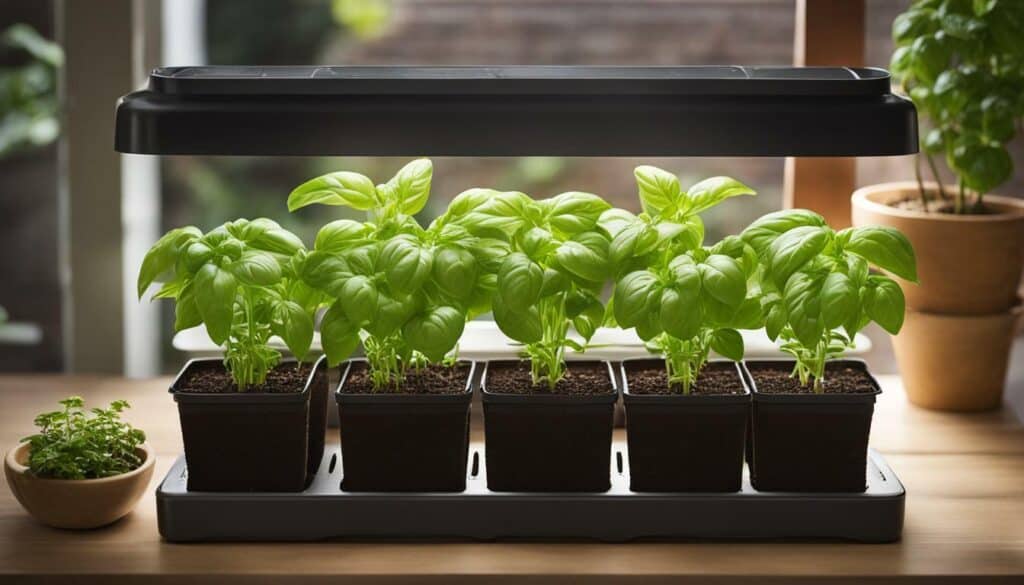
Meeting the Sunlight Needs of Your Indoor Basil Garden
Basil plants thrive with ample sunlight, making it essential to meet their sunlight needs in an indoor setting. To grow healthy basil plants indoors, it is important to provide them with at least six hours of sunlight daily. When natural light is limited, fluorescent lights can be used for up to 10 hours a day. A combination of natural and artificial lighting is also an option.
The best spot for an indoor basil garden is a sunny window with southern exposure. South-facing windows receive the most sunlight throughout the day and are ideal for growing basil. If you don’t have a south-facing window, you can place your plants under grow lights. When using grow lights, keep them on for about 10 hours a day, making sure to turn them off at night to mimic natural lighting conditions.
In addition to lighting, it is important to consider temperature and humidity for your indoor basil garden. Basil plants require an average temperature of 70 degrees Fahrenheit or higher and a fair amount of humidity. Avoid exposing the plants to cold drafts or placing them near air conditioning or heating vents. When it comes to humidity, you can increase it by spraying the plants with water or placing them on a tray of wet pebbles.
Watering is crucial for basil plants, but it’s important not to overwater them. Aim to keep the soil regularly moist, providing about 1 inch of water per week. Container-grown basil may need more water than outdoor plants, so monitoring soil moisture and watering when the top layer of soil dries out or when the plant starts to wilt is recommended.
Regular pruning and maintenance are also essential for indoor basil gardens, as they promote growth and prevent fungal growth. Harvesting the leaves from the top down is recommended. Additionally, using a well-draining soil mixture with organic compost and placing the plants in a container with good drainage and airflow can help prevent moisture-related problems.
Starting basil indoors from seeds is also an option, but it requires more attention to lighting and moisture. After pre-moistening the soil, plant the seeds at the right time and cover them with plastic wrap or a dome during the germination stage. Once the seedlings emerge, remove the plastic and place the plants in a sunny window or under grow lights.
By following these tips, you can successfully meet the sunlight needs of your indoor basil garden and enjoy fresh and aromatic basil leaves year-round.
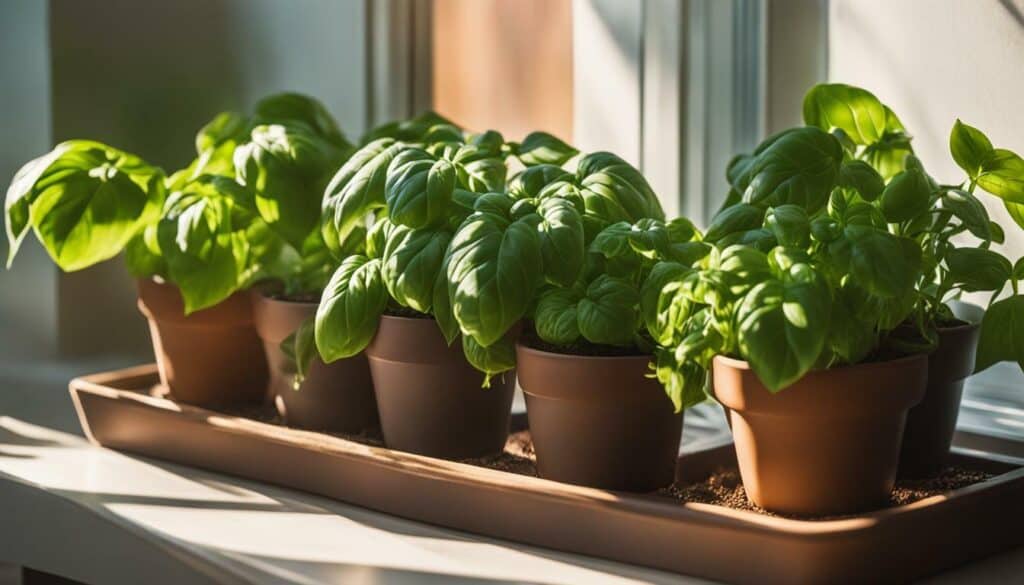
Nourishing Your Indoor Basil Garden with Proper Fertilization
Fertilizing your indoor basil garden is vital to provide it with the necessary nutrients for healthy growth and optimal flavor. When growing basil indoors, using well-drained, nutrient-rich soil is essential to prevent water stress and root rot. Proper drainage can be achieved by ensuring that the soil drains well after watering and using a pot with drainage holes.
| Basil Variety | Fertilizer Type |
|---|---|
| Sweet Basil | General Houseplant Fertilizer at Half Strength |
| Thai Basil | Organic Fertilizer for Flavoring Foods |
Depending on the variety and purpose of your basil, you can use a general houseplant fertilizer at half the recommended strength or opt for an organic fertilizer for flavoring foods. Applying a liquid fertilizer once every two weeks or a slow-release fertilizer every four to six months can provide your basil with the necessary nutrients.
Maintaining the pH levels between 6.0 and 7.5 is crucial for the health of your basil. You can test the pH level of your soil using a gardening kit or a pH meter. If the soil is too alkaline, adding acidic substances such as coffee grounds or vinegar can lower the pH. Conversely, if the soil is too acidic, adding alkaline substances such as limestone or eggshells can increase the pH.
Basil requires at least six hours of sunlight daily when grown indoors. Placing the plants in a sunny south-facing window or using fluorescent lights for about 10 hours can promote healthy growth. Regular repotting may be necessary due to the vigorous growth of basil plants.

By following these tips, you can ensure that your indoor basil garden thrives and provides delicious herbs year-round.
Pruning and Harvesting Your Indoor Basil Garden
Pruning and harvesting are essential for maintaining the health and productivity of your indoor basil garden. To ensure successful growth, it’s important to use well-drained, nutrient-rich soil and pots with adequate drainage to avoid root rot.
Fertilizing your basil plants is also crucial for their overall health. Depending on the variety and purpose of the basil, you can use a general houseplant fertilizer or organic fertilizer. Be sure to follow the instructions on the package to avoid over-fertilizing.
Basil requires at least six hours of sunlight daily, so it’s best to place the pots in a sunny window facing south or use fluorescent lights. Regularly check the pH levels of the soil to maintain healthy growth and keep it between 6.0 to 7.5.
Pruning is beneficial for basil as it encourages branching and more leaves, resulting in a healthier and more productive plant. Harvesting should be done by cutting off individual leaves or snipping stems a few inches down. Be sure to only harvest up to one-third of the plant at a time to avoid stunting its growth.
When temperatures are consistently above 50 degrees Fahrenheit, you can move your basil plants outdoors. But be sure to bring them inside before the first frost hits. With proper care and maintenance, you can enjoy fresh basil from your indoor garden year-round.
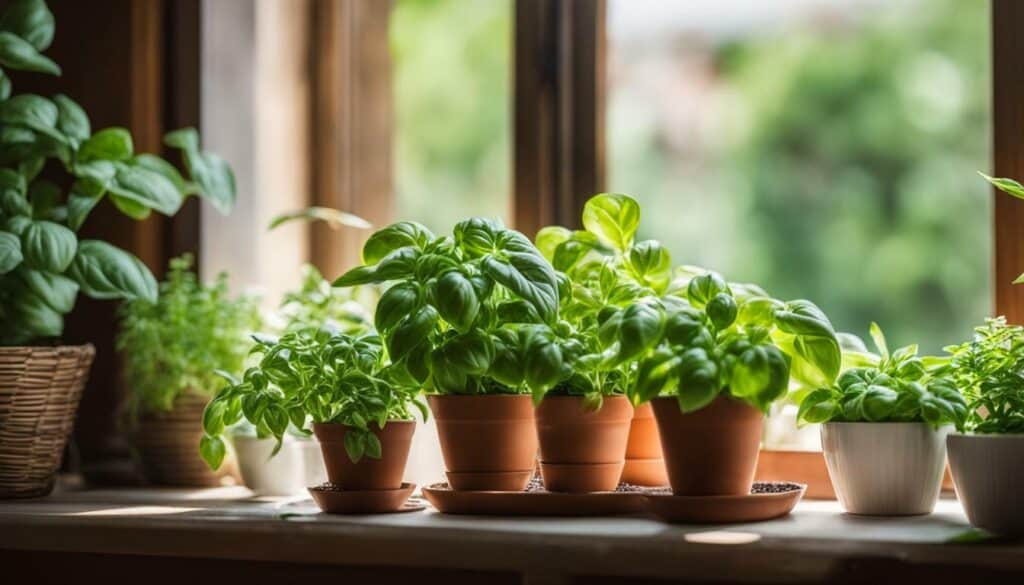
Starting from Seeds or Rooting Cuttings for Your Indoor Basil Garden
You have options when it comes to starting your indoor basil garden, whether it’s from seeds or rooting cuttings in water.
Starting basil from seeds is a simple and inexpensive way to grow your indoor garden. You can purchase basil seeds from your local gardening store or online. To plant the seeds, fill small containers with pre-moistened soil and sprinkle the seeds on the surface. Cover the container with plastic wrap to retain moisture and place in a warm area with indirect light. Seeds should germinate in about a week, after which you can remove the plastic and move the container to a sunny spot or under grow lights.
Once the seedlings emerge, you can thin them out to one or two plants per container, ensuring enough space for the roots to grow. Basil plants grow quickly and may require frequent repotting to accommodate their vigorous growth.
If rooting cuttings is your preferred method, start by selecting healthy stems with no flowers and cut them to 3 to 4 inches in length. Strip off any leaves below the waterline and place the stems in a glass of water. Roots should begin to form after a few days, and once they are about an inch long, the cuttings can be transplanted into fresh potting mix.
Basil cuttings should be kept in a warm, well-lit area and the soil should be kept moist. Once the cuttings have acclimated to their new environment and are growing well, you can begin pruning and harvesting leaves. Remember to start pruning from the top down as this will encourage healthy growth and prevent the plant from becoming too leggy.
Whether you’re starting from seeds or cuttings, growing basil indoors is a simple and rewarding experience. With proper care and attention, your plants will thrive and provide you with fresh, flavorful basil leaves year-round.

Transplanting Your Indoor Basil Plants Outdoors
If you wish to expand your basil garden outdoors, proper transplanting techniques are crucial for its successful adaptation. Basil is an easy-care herb that can be grown indoors, but it requires certain conditions to successfully transition to an outdoor setting. When transplanting basil, make sure to choose a well-drained, nutrient-rich soil that will provide adequate drainage.
Basil plants need at least six hours of sunlight each day, so make sure to place them in a sunny window or under fluorescent lights if necessary. It’s important to maintain healthy pH levels in the soil, which can be checked regularly. Basil plants also require regular watering and can benefit from the use of organic fertilizers.
When the basil plants are established and have branched out, they can be pruned and harvested for use in the kitchen. Basil can be grown from seed indoors, and once the seedlings have grown, they can be gradually acclimated to outdoor conditions before being transplanted. Another method of multiplying basil plants is by rooting cuttings in water and then transplanting them into fresh potting mix.
With these tips, you can successfully transplant your indoor basil plants outdoors and enjoy the fresh flavor of basil year-round.
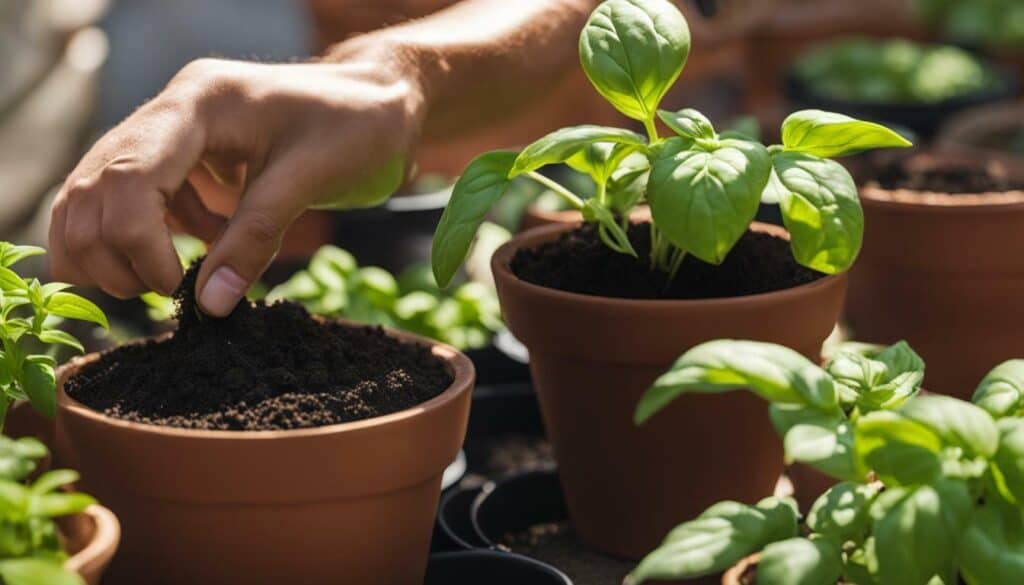
Remember to take care when transplanting your basil plants and to choose a suitable location that provides the right growing conditions. With the right care and attention, your basil garden can thrive indoors and outdoors.
Caring for Your Indoor Basil Garden: Additional Tips and Tricks
To ensure the success of your indoor basil garden, consider these additional tips and tricks for optimal care and growth. First and foremost, it is important to use well-drained, nutrient-rich soil in your container. Basil plants are not tolerant of water stress, making adequate drainage necessary to prevent root rot.
Fertilizing is also essential in caring for your indoor basil garden. For general basil growth, a general houseplant fertilizer used at half the recommended strength will suffice. Organic fertilizer is recommended for basil used for flavoring foods. Checking the pH levels of the soil and maintaining them between 6.0 and 7.5 is crucial for optimal growth.
Ensuring proper lighting is also important for your indoor basil garden. Basil requires at least six hours of sunlight daily when grown indoors. Placing the plants in a sunny window, preferably facing south, or using fluorescent lights for about 10 hours a day can provide the necessary lighting.
Pruning and frequent repotting may be necessary for vigorous growth. Regular pruning can encourage bushier growth and allow for continuous harvesting of fresh basil leaves. Good air circulation and excellent drainage are crucial, so choosing a container with ample drainage holes and using high-quality potting soil are recommended.
Watering your indoor basil garden regularly is also important, aiming for about 1 inch of water per week. The basil plants can be fed with a weak liquid fertilizer once a month if additional nutrients are needed.
When starting an indoor basil garden from seeds, use small containers filled with moist soil, provide plenty of light, increase air circulation and humidity, and keep the seedlings moist. Hardening off the plants before transplanting them outdoors is necessary for successful growth. Another method of propagating basil is by rooting stem cuttings in water and then transplanting them into fresh potting mix once they develop roots.
With these additional tips and tricks, you can enjoy a flourishing indoor basil garden year-round. Remember to regularly check your plants and make adjustments to their growing conditions as needed. By providing proper care and attention, your indoor basil garden will thrive and provide you with fresh, flavorful basil for all of your culinary needs.

Enjoying Fresh Basil Year-Round: Benefits of an Indoor Basil Garden
Cultivating an indoor basil garden offers numerous benefits that go beyond just having fresh basil at your fingertips. With the right growing conditions and care, you can enjoy a year-round supply of this delicious herb in the comfort of your own home.
The variety of basil plants available to indoor gardeners is vast, ranging from sweet Genovese basil to spicy Thai basil. Growing basil indoors allows for greater control over its cultivation, ensuring that you have access to fresh, organic herbs whenever you need them.
In addition to providing a constant supply of fresh herbs, an indoor basil garden can also add a touch of greenery and natural beauty to your home. Basil is an attractive plant with fragrant leaves and small white flowers, making it a great addition to any indoor herb garden.
Growing basil indoors also offers the benefits of being able to monitor and control the growing conditions, ensuring optimal growth and health. By choosing the right soil, providing ample light, and proper watering and fertilization, you can cultivate strong, healthy basil plants that will continue to produce for years to come.
Finally, an indoor basil garden can be a fun and rewarding hobby that provides a sense of satisfaction and accomplishment. As you watch your basil plants grow and thrive, you can enjoy the fruits of your labor by adding them to your favorite dishes and sharing them with family and friends.
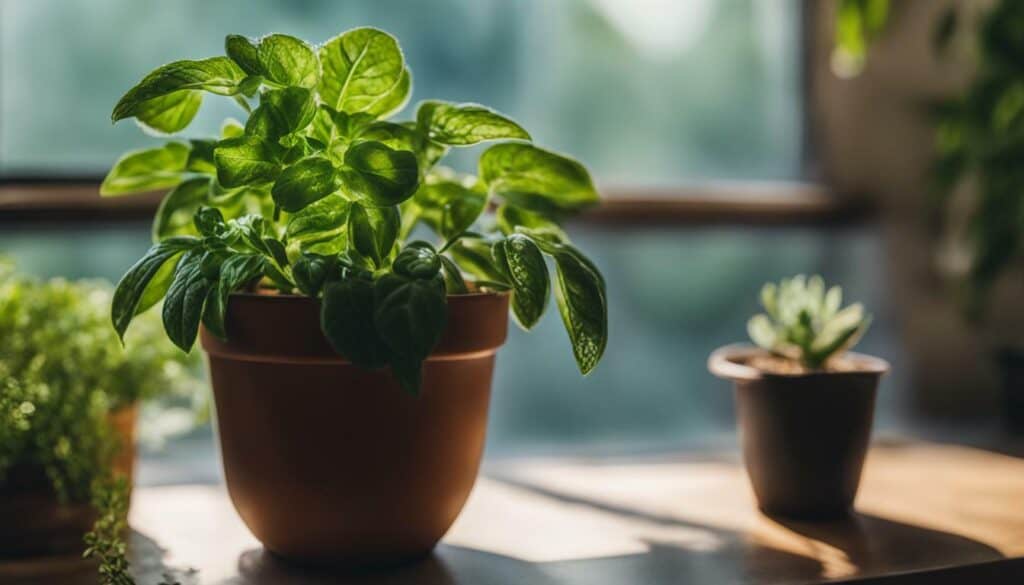
Whether you are an experienced gardener or just starting out, growing basil indoors is a great way to enjoy the many benefits of fresh herbs year-round. With a little care and attention, you can cultivate a thriving indoor basil garden that will provide you with delicious herbs and natural beauty for years to come.
Conclusion
With the right care and attention, you can enjoy the freshness and flavors of basil year-round by creating your own indoor basil garden. Growing basil indoors is a simple and rewarding endeavor that can provide you with a steady supply of fresh herbs for your cooking needs.
Whether you choose to start from seeds or cuttings, it is important to provide your basil with well-drained, nutrient-rich soil and adequate lighting. If natural sunlight is insufficient, fluorescent lights can be used. Monitoring temperature, humidity, and watering is crucial to ensure your basil’s health.
Regular pruning and harvesting can promote growth and maintain the desired flavor. With proper care, your indoor basil garden can be a long-term source of delicious and aromatic herbs for your culinary pursuits.
So why not give it a try? With a little effort and patience, you can enjoy the benefits of fresh basil year-round and add a touch of greenery to your indoor space.
Thank you for reading this guide on creating your own indoor basil garden. We hope it has been helpful and inspiring. Happy planting!
FAQ
Q: How do I grow basil indoors?
A: To grow basil indoors, you need well-drained, nutrient-rich soil and regular watering. Place the plants in a sunny window or under fluorescent lights for at least six hours a day. Check the pH levels of the soil regularly and fertilize with organic or general houseplant fertilizers. Pruning the plants encourages growth and allows for harvesting. Basil can also be grown from seed or propagated from cuttings in water.
Q: How much sunlight does basil need?
A: Basil requires at least six hours of sunlight per day. Place your basil plants in a sunny window or under fluorescent lights to ensure they receive enough light for optimal growth.
Q: How often should I water my basil plants?
A: Basil should be watered regularly, but be careful not to let the soil become soggy. Water the plants when the top inch of soil feels dry to the touch.
Q: Can I fertilize my indoor basil plants?
A: Yes, you can fertilize your indoor basil plants. Use organic or general houseplant fertilizers, depending on the purpose of your basil (culinary or ornamental). Follow the instructions on the fertilizer label for application rates and frequency.
Q: How do I prune my basil plants?
A: Pruning your basil plants regularly is important for encouraging growth and allowing for continuous harvesting. Use clean pruning shears to remove the top two sets of leaves on each stem. This will promote branching and bushier growth.
Q: Can I grow basil from seeds indoors?
A: Yes, basil can be grown from seeds indoors. Start the seeds in small pots or seed trays filled with well-drained soil. Keep the soil consistently moist and provide bright light. Once the seedlings have grown a few inches tall, they can be transplanted into larger pots or containers.
Q: When can I transplant my indoor basil plants outdoors?
A: Indoor basil plants can be transplanted outdoors once the danger of frost has passed and the weather has warmed up. Gradually acclimate the plants to outdoor conditions by placing them outside for a few hours a day and increasing the time each day.
Q: How do I care for my indoor basil plants?
A: In addition to regular watering and adequate sunlight, caring for your indoor basil plants involves monitoring temperature and humidity levels, ensuring good air circulation, and controlling pests. Keep the plants at a temperature between 65-75°F (18-24°C) and humidity levels around 40-50%.
Q: What are the benefits of growing an indoor basil garden?
A: Growing an indoor basil garden allows you to enjoy fresh basil year-round for cooking and adds aesthetic appeal to your indoor space. It also provides the convenience of having a readily available supply of this versatile herb.
Can I Use the Same Beginner’s Guide to Grow an Indoor Basil Garden?
If you’re wondering whether you can use the same beginner’s guide to growing basic herbs to cultivate an indoor basil garden, the answer is yes! With the right knowledge on soil, light conditions, and watering, you can apply the principles from your beginner’s guide to successfully grow basil indoors.
Source Links
- https://www.gardeningknowhow.com/edible/herbs/basil/information-on-how-to-grow-basil-indoors.htm
- https://www.thespruce.com/grow-basil-indoors-1902741
- https://www.bhg.com/gardening/vegetable/herbs/how-to-grow-basil-indoors/
- https://www.gardeners.com/how-to/basil-indoors/8930.html
- https://bonnieplants.com/blogs/how-to-grow/growing-basil
- https://www.epicgardening.com/growing-basil-indoors/
- https://www.fiskars.com/en-us/gardening-and-yard-care/ideas-and-how-tos/planting-and-prep/growing-basil-planting-and-harvesting
- https://savvygardening.com/growing-great-basil/
- https://kitchenherbography.com/does-basil-need-full-sun/
- https://www.gardeningknowhow.com/edible/herbs/basil/fertilizing-basil-plants.htm
- https://peacelovegarden.com/best-fertilizer-for-basil/
- https://howtoculinaryherbgarden.com/how-to-prune-basil-indoors/
- https://www.thespruce.com/how-to-prune-basil-5222034
- https://savvygardening.com/how-to-trim-basil/
- https://howtoculinaryherbgarden.com/grow-basil-from-seed-indoors/
- https://savvygardening.com/growing-basil-from-seed/
- https://savvygardening.com/growing-basil-from-cuttings/
- https://www.homestratosphere.com/transplant-basil/
- https://www.botanix.com/en-ca/botanix-specialists-blog/basil-in-containers-in-garden
- https://www.bakingoutsidethebox.com/transplanting-basil-indoors/
- https://www.growforagecookferment.com/reasons-to-grow-basil/
- https://www.backyardboss.net/benefits-of-growing-basil-in-your-home/
- https://extension.usu.edu/yardandgarden/research/basil-in-the-garden
- https://hgic.clemson.edu/factsheet/basil/

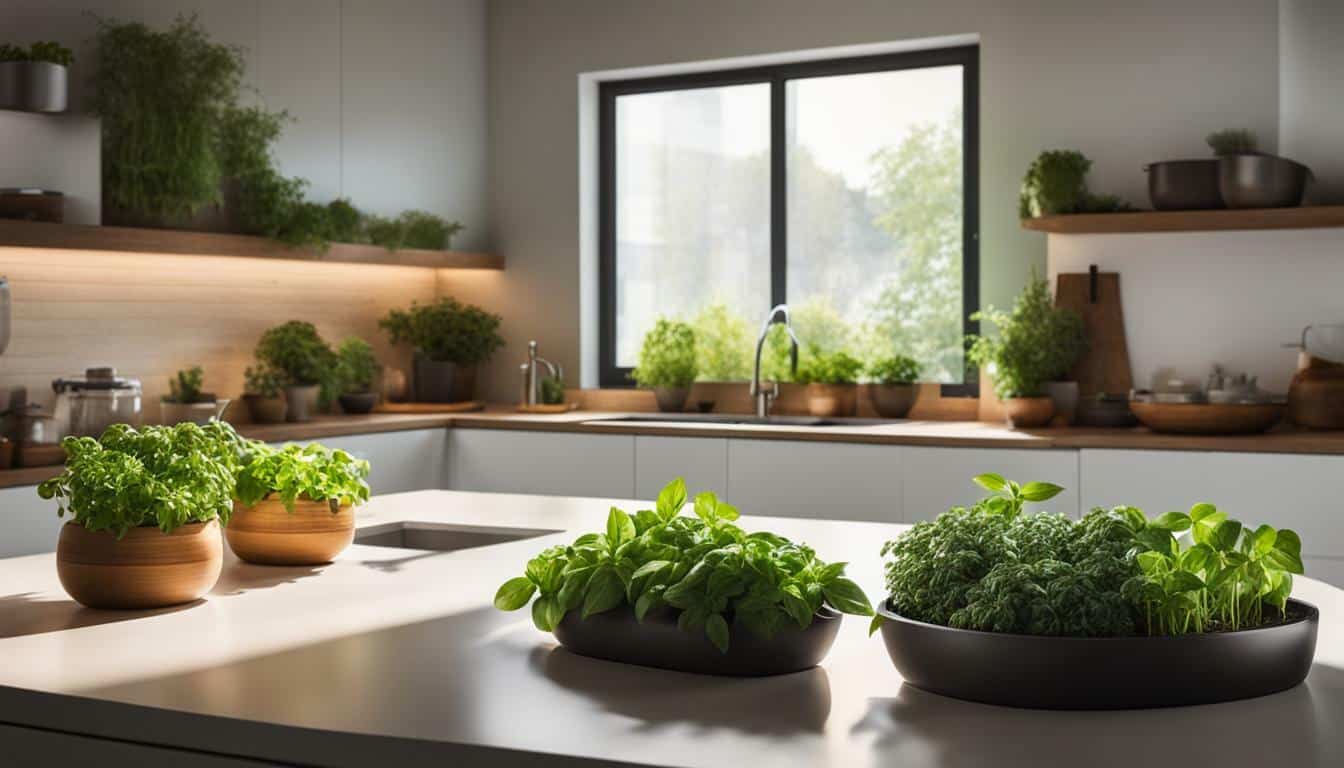



Leave a Reply